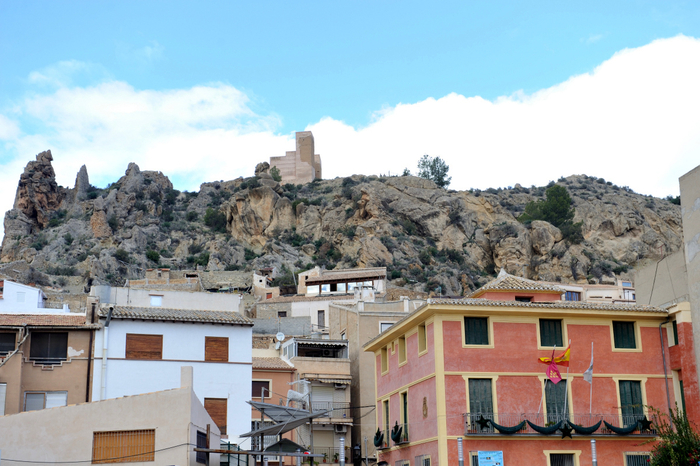Blanca castle

The castle was built during the 500-year Moorish occupation of Spain
The ruined castle of Blanca stands on a hilltop in the Sierra del Oro high above the modern-day town, which lies on the south-eastern slopes of the same mountain. This location gave the castle its strategic importance, since it affords views over the valley of Ricote and a large part of the plains alongside the River Segura.
Not many details are known about the construction of the castle, but it is believed that it dates back to the 12th century, when the Region of Murcia was still ruled by the Moors (who controlled southern Spain from 711 AD onwards, only finally losing their last stronghold in the Kingdom of Granada in 1492). Some sources speculate that it was built by Muhammad ibn Mardanis (also known as the Rey Lobo, or Wolf King), who was keen to consolidate the route between Molina de Segura and Cieza along the valley (see the History of Blanca for more details)
The peak on which it stands, 223 metres above sea level, is known as Peña Negra, and gave the town its original name, which was Negra and meant black, a reference to the black rock. The castle played an important part in maintaining military control and was pivotal during the last few years of Moorish rule in what is now the Region of Murcia, when in 1228, Yusuf Ibn Hud, the Moslem King of Murcia, led an uprising from Negra against the Almohad caliphate. Although his rebellion was successful, after he died ten years later there was anarchy and chaos in the kingdom of Murcia in the years prior to the Christian Reconquista in 1243.
In 1243, Murcia was reconquered by Christian forces from Castilla y León in the north of Spain as part of the Reconquista, the gradual process of recovering land occupied by the Moors. At this point the Moorish forces were pushed back into modern-day Andalucia and the Kingdom of Granada where they remained until 1492 when the Reconquista was finally concluded. In 1243 the forces were led by Prince Alfonso of Castilla, who was later crowned King Alfonso X of Castilla. Even though the takeover was fairly straightforward, mediaeval Murcia remained a dangerous place due to the constant skirmishes with the remaining Moorish forces just a short distance away, and the importance of re-enforcing fortifications meant that many castles were strengthened and rebuilt, enhancing the former Moorish fortifications.
Alfonso incorporated the Ricote valley into the area administered by the city of Murcia and during his reign it was governed as a Castilian protectorate by Enrique Pérez de Arana and Pedro Peláez de Contreras.
In 1281 Sancho IV transferred the valley to the control of the religious and military Order of Santiago, warrior knights dedicated to the service of the church, who controlled vast swathes of Murcia. With the ever-present threat of Moorish border raids security was of vital importance and the castle continued to dominate the town in the period when its name was changed from Negra to Blanca, and under the rigid stewardship of the Knights of Santiago, agriculture prospered. At this point the area was fairly well settled as many of the Moorish farmers had elected to remain and pay their taxes to the order, but in 1492 the Catholic Monarchs ordered the expulsion of all Moors who refused to convert to Christianity.
In Blanca this situation was somewhat complicated as although many of the Moslem residents converted, they were still not given the rights and status of other native residents and population levels fluctuated as they came and went (more detail of what happened in the History of Blanca).
In 1448 the castle of Blanca became caught up in mediaeval politics and was attacked during a feud between two of the members of the powerful Fajardo family, Pedro Fajardo and Alonso Fajardo "el Bravo", and was successfully besieged. This was to prove the most noteworthy incident during its history, as following the expulsion of the Moors in 1492 the need for fortifications diminished and in the relatively peaceful times which followed the fortress was no longer necessary. It soon fell into disrepair, and has not been restored since.
Nowadays the most notable remnants of Blanca castle are the three towers, which are linked by a double wall. Behind this wall is a well which was dug into the rock, but little else remains of the other walls which would have enclosed the castle. It has been deduced that the towers used to be approximately twelve metres high, and that arrow slits were placed near the top.
Remains on the eastern side of the castle suggest that there may have been another defensive structure placed here prior to the construction of this castle.
It is possible to reach the castle on foot from the town centre by using a steep stepped path from the old town centre, and although the remains of the building are not well preserved it’s worth a visit if only to admire the panoramic views which caused the location to be chosen in the first place, although care should be exercised.
article_detail

|













